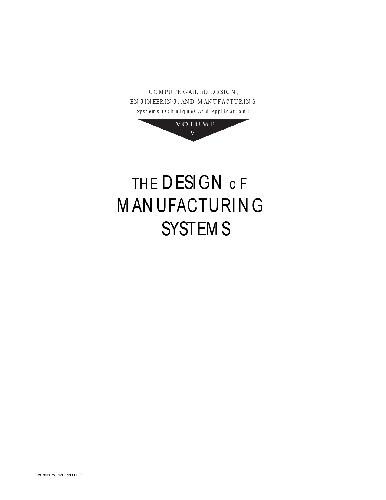Cornelius Leondes0849309972
Table of contents :
THE DESIGN OF MANUFACTURING SYSTEMS……Page 1
Preface……Page 4
Editor……Page 5
Contributors……Page 6
Contents……Page 7
1.1 – Introduction……Page 8
1.2 – The Long-Range Planning Problem……Page 9
1.3 – Deterministic Models……Page 11
1.4 – Hedging against Uncertainty……Page 25
1.5 Conclusions……Page 30
References……Page 31
2.1 – Introduction……Page 33
2.2 – Definition of Features and Feature Taxonomies……Page 34
2.3 – Feature-Based Design Approaches……Page 35
2.4 – Automated Feature Recognition and CAD Representation……Page 36
2.5 – Feature-Based Design Applicatoins……Page 37
2.6 – Research Issues in Feature-Based Manufacturing……Page 38
References……Page 47
3.1 – Introduction……Page 53
3.2 – Literature Review……Page 54
3.3 – Flexible Layout Configurations……Page 58
3.4 – Measuring Layout Flexibility……Page 62
3.5 – A Procedure for Flexible Layout Design……Page 65
References……Page 71
4.1 – Introduction……Page 74
4.2 – The FMS Operational Model and the Manufacturing System Deadlock……Page 78
4.3 – The Single-Unit RAS and the Deadlock Avoidance Problem……Page 85
4.4 – Single-Unit RAS Admitting Polynominally Computable Optimal DAP……Page 92
4.5 – Polynominal-Kernel Deadlock Avoidance Policies for Single-Unit RAS……Page 95
4.6 – Efficiency Considerations for Polynominal-Kernel DAPs……Page 100
4.7 – Additional Issues and Future Directions in FMS Structural Control……Page 103
References……Page 104
5.1 – Introduction……Page 108
5.2 – Concept, Implementation and Evaluation of Human-Centered Systems……Page 109
References……Page 125
5.3 – Shop Floor Control: NC Technology for Machining Complex Shapes……Page 126
5.4 – Shop Floor Implementation Information Support: Developing User-Oriented Shop Floor Software……Page 132
5.5 – Shop Floor Cooperation Networks: A Shop Floor Production Planning System for Groupwork……Page 139
References……Page 149
5.7 – Enterprise Networks: The Reengineering of Complex Software Systems……Page 150
5.8 – Assessomg the Human Orientation of New Control Technology: The Example of Slovenia……Page 154
5.9 – Clean Technology in Industry Today……Page 158
References……Page 163
6 – Model-Based Flexible PCBA Rework Cell Design……Page 164
6.1 – Introduction……Page 165
6.2 – Overview of Printed Circuit Board Assembly Technology……Page 166
6.3 – Rework Technology and Assembly Robots……Page 170
6.4 – Overall Development Planning……Page 171
6.5 – Detailed Studies of Rework……Page 172
6.6 – Determination of Reflow Methods and Automated Rework Techniques……Page 174
6.7 – Determination of Other Rework Requirements……Page 181
6.8 – Development of Core Automated Rework Procedures……Page 184
6.9 – Equipment and Rework Tooling Selection……Page 185
6.10 – Subsidiary Automation of Tools……Page 188
6.12 – Detailed Automated Rework Procedures……Page 191
6.13 – Total System Modeling Requirements……Page 194
6.14 – Robot and Vision System Software Development……Page 198
6.15 – System Integration and Interfacing……Page 199
6.16 – Evaluation……Page 202
6.17 – Conclusion……Page 204
References……Page 205
7.1 – Introduction……Page 208
7.2 – Model of Conceptual Design……Page 218
7.3 – Implementation of the Model……Page 226
7.4 – Assessment of Appropriateness of Working Principles and Models of Shape……Page 229
7.5 – Application……Page 233
7.6 – Assessment of a CAD System for the Conceptual Design of Mechanical Drive Units……Page 241
7.7 – How Should We Continue?……Page 242
7.8 – Conclusions……Page 243
References……Page 244
8.1 – Introduction……Page 246
8.2 – Techniques of Computer Assembly Planners……Page 248
8.3 – Methods for Input/Output Representation……Page 256
8.4 – Applications in Aircraft Frame Assemblies……Page 259
References……Page 270
9 – Petri Net Modeling in Flexible Manufacturing Systems with Shared Resources……Page 273
9.2 – Petri Net Models for a Class of FMSs……Page 274
9.3 – Liveness Conditions for R2PN Models……Page 276
9.4 – Deadlock Avoidance Controllers for R2PN Models……Page 279
9.5 – Examples……Page 288
9.6 – Conclusion……Page 291
References……Page 292







Reviews
There are no reviews yet.